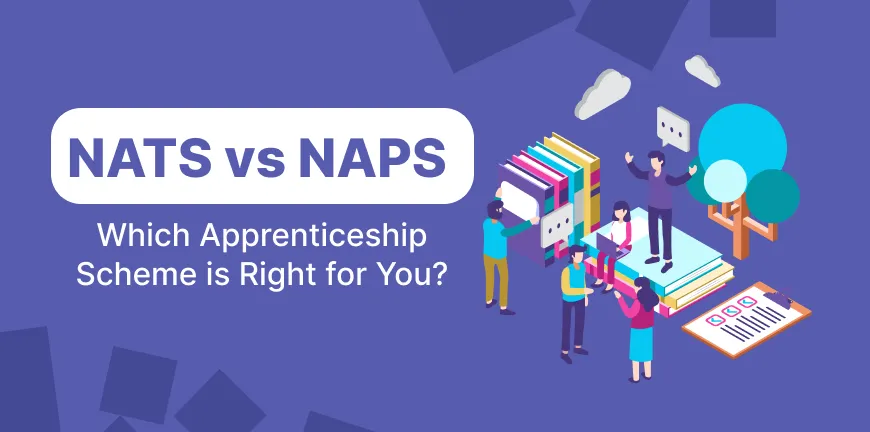
Boosting HR (Human Resources) Effectiveness through Employee Advocacy
30/10/2023
Strategies and Tips on How to Improve the Hiring Process
03/11/2023The role of education in transforming society and livelihood of residents has been phenomenal over the years. For India, it started in 1938, when Mahatma Gandhi envisaged “Nayi Talim” that set new grounds for education and its impact on the society.
Over the years, many strides have been made to enhance educational standards and many new tenets have been added to it. The introduction of various types of apprenticeships was one of the most successful one.
Apprenticeships is a time-tested approach towards building a skilled workforce. It has been recognized as one of the most effective and invaluable forms of recruitment.
Why is it so effective?
An apprenticeship’s goal is to prepare you for a specific career while helping you gain the qualifications most companies demand in that industry.
Learning on the job or on the job training is one of the most effective ways of enabling students or individuals to become adept and skillful at their jobs. During apprenticeships, not only do individuals receive on the job training but also earn a particular stipend amount while doing so.
What is an Apprenticeship?
Apprenticeship is a skill-based training program wherein an individual is hired as an apprentice by a company is provided with the necessary training to make them able at the job. Post the completion, apprentices receive a nationally recognized certificate.
During the apprenticeship an individual typically gains classroom (theory – 30%) learning for a short period, followed by on-the-job (practical – 70%) training.
In India apprenticeships last from anywhere between 6 months to three years depending on the trade and industry they choose to be a part of.
What are the Types of Apprenticeships?
It’s important to note that the naming conventions and qualification levels for apprenticeships can vary from country to country. Additionally, apprenticeships are continuously evolving to meet the changing demands of industries, so new levels and categories may emerge over time.
In India, there are two main fields in apprenticeship training-
- Designated trade– any trade or occupation as notified by the government.
- Optional trade– any trade or occupation decided by an employer.
Apprentices can be provided by either depending on certain factors like educational qualification, age etc. But all the apprentices fall under one of the categories mentioned below:
- Trade apprentices
- Graduate apprentices
- Technician apprentices
- Technician(vocational) apprentices
- Optional trade apprentices
Here’s a detailed information about the types of apprenticeship training available for candidates with different educational qualifications-
1. Trade Apprenticeship (Level 1 and level 2)- Foundation or Intermediate level
These programs are designed for individuals who have little or no prior experience in the chosen trade or profession. They provide basic skills and knowledge to prepare individuals for entry into a formal apprenticeship.
A student or an individual undergoing training in any designated trade- trade/ occupation falls under this category.
8th, 10th, 12th standard and ITI pass-outs are eligible to undergo apprenticeships under designated trade. Some trades even consider B.Sc pass outs.
2. Technician (vocational) Apprenticeship (Level 3)- Advanced level
Advanced apprenticeships are suitable for individuals who have some experience or training in their chosen field. They offer more in-depth training and knowledge, enabling apprentices to develop a higher level of skill and expertise.
A technician (vocational) apprentice is someone who holds certification in vocational course after completing secondary education recognised by All India council is eligible for this apprenticeship.
3. Technician Apprenticeship (Level 4+) Higher level
Higher apprenticeships are more advanced and is perfect if the individual is seeking to attain a higher level of expertise and responsibility in their field.
Technician apprentices usually hold a diploma in engineering or non-engineering field, and are eligible for apprenticeship training in a designated trade.
Common sectors where technician apprentices are most sought after include engineering, healthcare, and business management.
4. Graduate Apprenticeship (Level 6 and 7)- Higher level
This program is for individuals with a high level of education who seek on-the-job training to upskill themselves as they have an understanding of the subject but lack practical skills required for the real world of work.
Graduate apprentices hold a degree in engineering/non-engineering fields and are eligible for an eligible for apprenticeship under a designated trade.
Most sought after fields for graduate apprentices include engineering, business, healthcare, and IT.
The Government of India has launched various training and upskilling programs to promote apprenticeships and skill development, such as the National Apprenticeship Promotion Scheme (NAPS), National Apprenticeship Training Scheme (NATS), Technical Inter Training program (TITP), DDUGKY and the Skill India program.
The aim of these programs is to increase the availability of apprenticeship positions and improve the quality of training provided to apprentices.
What are the Types of Apprenticeships (based on Industries)?
Working at an apprenticeship is an effective way to gain experience in certain career fields. Most businesses use apprenticeships to train new hires or to help current employees further develop their skills. Some of the industries that apprenticeships can aid with providing skilled labour are-
1. Agriculture
One of the biggest and most diverse sectors in India, the agricultural sector is one that constantly requires skilled labour. While it does require you to work outside an enclosed space most times, there are roles that allow you to work in an indoor environment as well. Some of the agricultural apprenticeships to choose from are-
- Veterinary
- Game and wildlife management
- Environmental conservation
2. Arts and Media
If you are looking to pursue a career in media and publishing sector, fashion or arts, an apprenticeship in the industry with a known employer can help you acquire the skills you need to excel. Popular apprenticeships in this industry are-
- Journalism
- Creative and digital media
- Live events and promotions
- Lead generation specialist
- Digital marketing
3. Construction
Design, building, Road maintenance, maintenance of buildings, airports are only some to name from the many major construction projects that take place around the clock. Certainly, a wide range of apprenticeships must be available in the construction industry. To name a few-
- Plumbing
- Civil Engineering construction
- Construction management
- Electrical and electronic services
4. Business Management and Administration
Organizational and communication skills are some of the most sought after skills if you want to make it big in business and administration sectors. Some of the apprenticeships under these sectors are –
- Human resources management
- Social media and digital marketing
- Project management
- Business innovation and growth
5. Legal, Finance and Accounting
There is no business in the world that can function without the aid of accounting and finance professionals. An apprenticeship in this area will give you on-the-job experience that can steer you to multiple routes.
After an apprenticeship in the field, some of the roles you can consider getting into are-
- Barrister/ Lawyer
- Bank manager
- Insurance broker
- Paralegal
- Accounts and finance administrator
6. Engineering and Manufacturing
Every object or instrument we use is a product of engineering and manufacturing. It will never go out of demand as long as the human race exists, so it’s important that people continue to learn this valuable skill. As an apprentice you will get a hands-on experience in the field in the operational side of things. Some of the top options include:
- Nuclear engineering degree apprenticeship
- Machine engineering
- Engineering technician
- Production control
- Aviation operations
- Public transport engineering and maintenance
- Marine industry
- Power engineering
- Rail engineering and services
7. Healthcare and Science
This can include anything and everything in dental, medical and pharmaceuticals. An apprenticeship in any one is great cos the medical field is always booming.
Some of the apprenticeships you could consider are-
- Nurse
- Dental nursing
- Pharmacy assistant
- Healthcare science
- Medical receptionist
8. Training and Education
Teaching skills, leadership skills and communication skills lead these sectors. You also get to work with people of different backgrounds and ages in this industry. Types of apprenticeships under this sector include-
- Learning and development
- Support teaching and learning
- Physical education learning
- Learning support
What are the Trending Apprenticeship profiles in 2026?
With the advent of new technology 5G, IoT, Artificial Intelligence, Robotics and cloud computing, 2025 was marked as the year of the apprentice. While there will always be demand for apprentices in the traditional and conventional industries, the scope of opportunities for apprentices in various other tech and non tech fields will increase as well.
Some of the top apprenticeship profiles that have witnessed a surge in demand in 2026 are-
1. IOT Professionals
The internet of things has proven to be a game changer in IT sector. Upskilling in IoT will be invaluable for candidates as it brings plenty opportunities across sectors like supply chain, management, telecommunications, tech startups etc.
Skills in these fields can fast track the career path of potential individuals.
- IT security
- Machine learning
- Hardware interfacing
- Business intelligence
- UI/UX Design
2. AI Engineers
Machines are taking over most of the repetitive manual work that humans have been spending hours of time doing for years. With AI taking over most tasks in almost all fields, especially the tech and manufacturing industry, upskilling in the field will not only fetch you a solid career in the fied but also can keep the job roles from being redundant.
As an AI engineer you will build and deploy AI models to acquire business insights, create and maintain AI infrastructure that will streamline organizational processes.
3. Cloud Computing Professionals
Cloud computing is dominating across industries since the pandemic with the acceleration of digital transformation. Good news for apprentices can dive into cloud computing and get hired by employers as there is a huge talent gap in the industry due to skill deficiency.
The top skills in demand in the field of cloud computing are-
- AWS/Azure
- Cloud migration
- SAP
- Cloud Security
- ML/AI
4. Data Science/ Analytics Professionals
Data is integral for all businesses. Sectors like IT, aviation, education, and manufacturing must leverage data in order to make informed, strategic decisions. It has also been one of the most sought-after fields by the youth.
If you have a flair for mathematics and statistics, a career in data science is for you. An apprenticeship that moulds your skills in the field is just what you need.
Apprenticeship Programs for the Win
Apprenticeship programs are undeniably a win-win solution for individuals and businesses alike. Time and again they have proven to be a powerful force in shaping successful careers and fostering a skilled workforce.
For individuals, they open doors to professional growth and financial stability, enabling them to chart their own paths towards success. On the other side of the equation, businesses can reap substantial rewards from apprenticeship programs as they get access to a pool of motivated and highly trained talent, ready to contribute immediately to the organization.
If you are an employer looking to employ apprentices through an apprenticeship program, contact Alp Consulting today. We offer support to employers to implement various types of apprenticeships that help them gain skilful candidates while building a solid talent pipeline for the future.
FAQs- Frequently Asked Questions
1. What is an apprenticeship?
An apprenticeship is a type of training program where the trainees get paid and are also trained to learn a skill trade while working alongside experienced professionals in an organization.
2. How many types of apprenticeships are there?
Apprenticeships are categorized based on different levels like intermediate, advanced, higher, degree and various occupational fields like IT, Healthcare, Engineering, and Retail.
3. What are the four types of apprenticeships?
There are four main types of apprenticeships, categorized by skill level and qualification are Intermediate (Level 2), Advanced (Level 3), Higher (Levels 4-7), and Degree (Levels 6-7).
4. What are the main categories of apprenticeships?
Apprenticeships are divided into various categories based on the level of qualification (Intermediate, Advanced, Higher, Degree) and the type of training/sector, like skilled trades, professional fields (IT, healthcare, finance, law), and technical roles (engineering, technician).
5. How long does an apprenticeship typically last?
An apprenticeship usually lasts for 4 years, during which time there are 3 different periods of off-the-job training.
Contact Us For Business Enquiry

Suresh Ramkrishna
Suresh Ramkrishna is the Operations Manager at Alp Consulting Ltd., with over 30 years of extensive experience spanning recruitment operations, sourcing, supply chain management, and client relations. At Alp, he leads the Search & Staffing Practice, specializing in bilingual and niche skill hiring while overseeing Japanese language and TITP (Technical Intern Training Program) initiatives. He also manages NAPS (National Apprenticeship Promotion Scheme) training programs, fostering skill development and workforce readiness across industries. Previously, he spent over two decades in the apparel export industry, managing vendor development and international sourcing for top global brands. Suresh’s leadership blends strategic talent acquisition with operational excellence across diverse industries.




